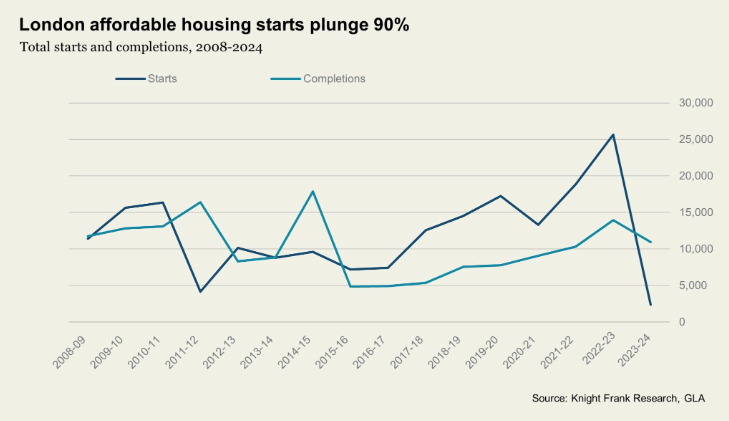Pre-2022 investing strategies don't work anymore
Making sense of the latest trends in property and economics from around the globe
5 minutes to read
"Owning the right real estate has never been more important," Landsec chief executive Mark Allan says in the group's annual results this morning.
Indeed, as the dust settles on the fastest cycle of interest rate hikes since at least the late 80s, the difference in the outlook for the 'haves' and 'have nots' of commercial real estate looks stark. New and refurbished office lettings in London, for example, have grown by 28% since the pandemic, whilst secondary offices have fallen by 44%, according to Knight Frank research. This polarisation is being mirrored to a greater or lesser extent in other locations and sectors.
There are shifting themes that impact these figures - the proposed MEES legislation* and the unwinding of various pandemic-related themes, for example - but the normalisation of interest rates has ushered in a new era: one in which the value drivers in real estate is about more than just ultra-cheap money and sector themes, says Mr Allan:
"For much of the decade leading up to 2022, creating value in real estate was often about leveraging up a spread between rental yields and ultra-low borrowing costs or picking high-level sector themes. The significant rise in cost of capital across the globe has not only changed the former but also the latter, as shown by the challenges faced by low-margin online retail models and the shift back to physical retail. As such, irrespective of sector, quality has become a much more important driver of future performance."
Value stabilisation
Pricing for the better assets in the right locations has been stabilising for some time. In the West End, prime net initial yields have been unchanged for six quarters, according to Knight Frank's London Office Market Report. In the City & Southbank, yields have been stable for four quarters. In the more debt sensitive City market, the difference between the risk-free rate of interest and prime yields is the largest since the start of interest rate tightening cycle in Q4 2022.
While Landsec said average values had continued to adjust, it added that "there are increasingly signs that this is now coming to an end."
"The relative stabilisation of long-term rates is a clear positive and reflecting the historically attractive pricing of good quality income in London and major retail, we are starting to see interest emerge from investors who have not been active in these markets for some time. As such, we expect activity levels to pick up from here. The refinancing of cheap debt issued before 2022 remains a challenge for parts of the sector, yet absent any further macro shocks, we think the value of high-quality assets has largely bottomed out and will start to grow in the foreseeable future as rents rise."
You can read the full update here.
Mortgage rates
This time last week, we were digesting the minutes of the latest Bank of England report. The Bank held the base rate at 5.25%, but a more benign set of inflation forecasts and several soothing statements from Governor Andrew Bailey looked likely to settle some of the volatility we'd been seeing in long term borrowing costs.
That has proven to be the case over the past week, and three major lenders have responded by cutting mortgage rates. Barclays will reduce fixed rates on purchase and remortgage deals by up to 0.45 percentage points this morning, according to the Times. HSBC will reduce interest rates on more than 100 of its deals, and TSB has cut rates on some of its two and five-year deals by up to 0.1 percentage point.
We were sceptical that mortgage rates would rise much on the way up - these are defensive moves following a price war - and we feel the same now they are falling again. That said, this will probably prompt a response from competitors, Hina Bhudia of Knight Frank Finance tells the paper:
“HSBC already had many of the cheapest deals on the high street, so this is quite a statement of intent. We’ll have to wait and see but I’d be surprised if we don’t see more lenders cut rates in response.”
Affordable housing
Affordable housing starts in London fell an incredible 90% to just 2,358 in the 12 months to end March 2024, down from 25,658 the previous year, according to official figures published this week.
Our own Anna Ward shares some thoughts here and this piece in Building is rich in detail. With borrowing costs at this level, many housing associations can't make development stack up - Indeed, development is considered discretionary spending in the sector, Paul Hackett, chief executive of newly merged London-based association Southern Housing, tells Building:
“There’s a risk that the sector is seen as crying wolf, but this time it really is terrible. Associations will hand grants back if appraisals don’t work.”
In addition to rising finance and build costs, housing associations are also having to spend more cash on existing stock - fire safety, fixing ageing housing and addressing damp and mould issues.

In other news...
*Thank you to those of you that wrote in to remind me that I failed to make clear in Wednesday's note that future deadlines in the MEES legislation are still proposals. Flora Harley reminds me that, in October last year, the government noted that "the proposed timelines within the original consultation will require updating to allow sufficient lead in time for landlords and the supply chain," and the details "will be published in due course."
Elsewhere - Student divestment victories feel good but do little (Bloomberg), BoE's Greene says she wants more evidence of waning inflation persistence (Reuters), Hamptons-Maldives mashup is coming to the Caribbean (Bloomberg), and finally, China removes mortgage rate floor for individual homebuyers (Bloomberg).